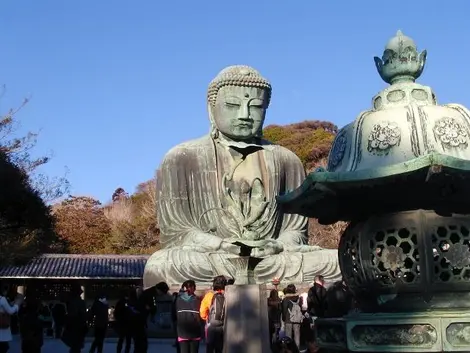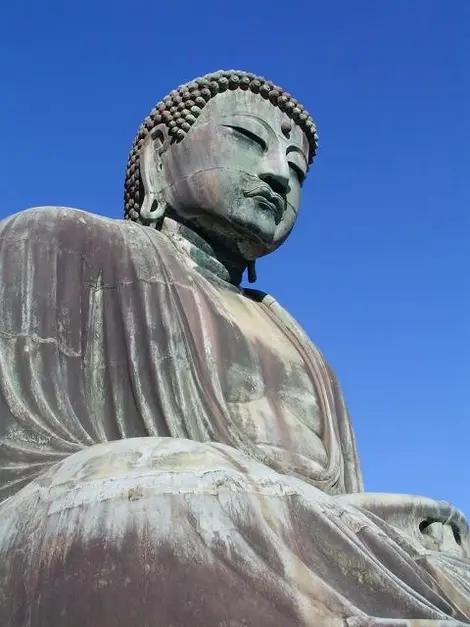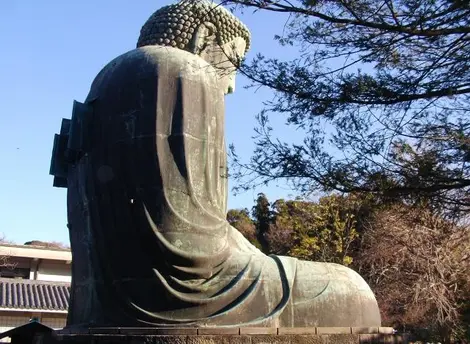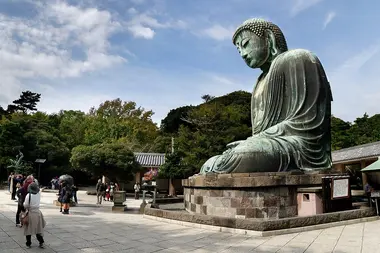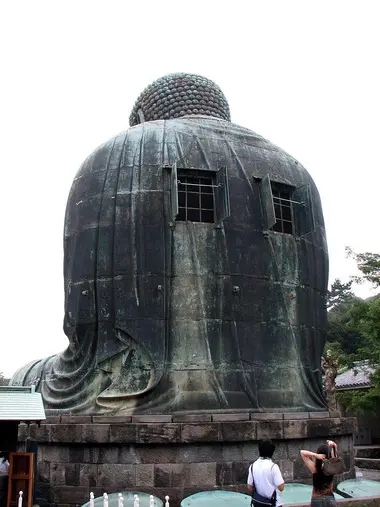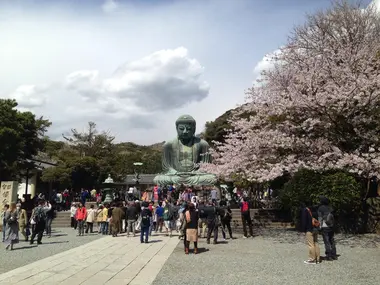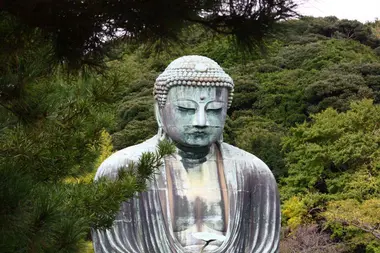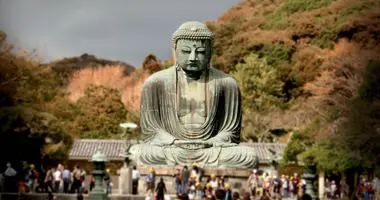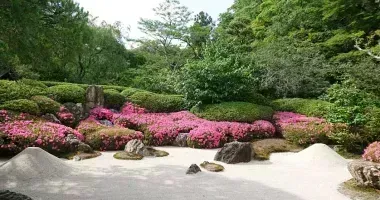Kamakura Daibutsu 高徳院の大仏
The bronze giant of the Kôtokuin temple
All that remains of the ancient Kotoku-in temple is its jewel which, for centuries, has marked its existence: the Great Bronze Buddha. For nearly eight centuries, the great Buddha "daibutsu" of Kamakura, the emblem of the city, has attracted crowds. Unfazed, he watches over the ancient capital and its inhabitants, but this national treasure has witnessed periods of war-ridden turbulent ages.
The mysterious history of Daibutsu
Much has been said and written about Kamakura Daibutsu, but historical data remains scarce and sometimes contradictory. It is not known who sponsored it although legend says that it was to grant the wish of the founder of the city, the shogun, Minamoto no Yoritomo, who died fifty years earlier, that the Buddhist monk Joko collected donations to have a large Buddha erected, in the same image of the one in Nara, Todaiji temple, as Yoritomo would have liked.
First built in wood around the 1240s, it was swept away by a storm five years later and rebuilt in a bronze statue, as the statue has survived the centuries, almost intact. Who was the sculptor? When was its construction completed and where were the 121 tons of bronze used, came from? All remains a mystery...
- To read also: The giant Buddha of Todai-ji
The turbulent history of the great Buddha
Its construction would have started in 1252 and it was sheltered in the Daibutsu-den hall of the Kotoku-in temple. According to some chronicles, the temple was damaged by typhoons in 1334 and 1369, and an earthquake in 1498, finally destroyed the building. But other documents trace the destruction of the temple to an earlier date.
It is therefore difficult to know precisely as the statue has been left in the open air and why the temple was never rebuilt.
What is certain is that the statue and its building had to deal with several large typhoons and even a tsunami early in its existence. This was followed by more devastations and nature: typhoons, sea winds, bird droppings and finally the great Tokyo earthquake in 1923 where the giant moved 50 cm but held on to its structure.
In 2016, the statue was given a full restoration and facelift. Conclusion: at more than 750 years old, the Big Buddha is in great shape!
- Read also: The Ryôzen Kannon, a giant statue in Kyoto
A bronze giant one must visit!
If we do not know the artist who produced the statue, specialists agree that his style was influenced by the Kei school of sculpture (a school that appeared at the beginning of the Kamakura period, 1185- 1333) as well as by a Chinese school of the Song dynasty (960–1279). Daibutsu is considered a classic example of the Buddhist sculptural style of the Kamakura period .
- Read also: Buddhist statuary
From a distance, his head may seem disproportionate to his body but it is voluntary, the closer you get, the more the whole and becomes harmonious ... Just like the path that leads to Buddha Amitabha and his world of peace and harmony as his hands are joined in a position of great meditation.
At 11.31 meters high (13.35 meters including the platform), it is the second-largest seated bronze Buddha in Japan. It was cast in several successive layers of bronze with two small windows in its back, it should be known that they were used to pour the earth and the molding used to erect the statue. To unravel the mysteries of its imposing stature, enter the interior of the monument and discover the ancient techniques of its assembling.
Imposing figure: it weighs 121 tons. Her face is 2.35 meters high, her eyes are one meter wide each, her mouth is 82cm while his long ears are 1.90 meters, and his hairstyle features 656 small individual curls.
Originally, the statue was completely gilded, but weathering has eroded its gold cover over centuries. However, if you look carefully, you can still see some traces of it.
- Read also: Tôgan-ji, the green giant of Nagoya
Amitabha: the Buddha of the Pure Land
The Great Kamakura Buddha statue represents Amitabha Buddha (Amida Butsu in Japanese) who is worshiped by adherents of the Buddhist sects of the Pure Land, a doctrine adopted by the Jodo and Jodo-Shinshu sects. in Japan. According to these Buddhist schools, those who venerate Amitabha are guaranteed to be reborn in paradise, that of the " Western Pure Land of Bliss" . Believers can achieve salvation by constantly reciting the Sutra invoking the name of the Buddha, which in Japanese gives the song "Namu Amida Butsu, Namu Amida Butsu…" (I search in Buddha Amitabha...).
- To read: Buddhism: a religion in Japan.
The domain of the Kotoku-in temple
To the right of the statue, sheltered under a roof, two huge straw sandals (warazori, 1.80 m high, 90 cm wide and 45 kilos), catch the eye. They are children of a club in the city of Hitachi-Ota (Ibaraki prefecture) who, after World War II , braided and offered these shoes to the big Buddha to travel around Japan in order to bring comfort to the Japanese people. And since then, every three years, the children of the same club have been responsible for making new sandals and offering them to the Kotoku-in temple.
In the park surrounding the big Buddha, there are several stone slabs erected in honor of famous people. Commemorative plaques and a tree planted by members of the Thai royal family show the importance attached to this sacred place.
Behind, at the far end of the park, is a small Korean-style building that houses an original Korean statue (but barely visible) of Kannon, (the goddess of mercy).
Address, timetable & access
Address
Phone
+81 467-22-0703Timetable
Enoden Line from Kamakura Station to Hase Station. On foot, the 3 km trail called "Daibutsu hike" takes you from Kitakamakura to Hase.Price
Adult: 300 yen / 150 yen: between 6 and 12 years old; free for children under 6 years old. (20 yen supplement for inside Daibutsu)Access
8 am-5pm dailyWebsite
http://www.kotoku-in.jp/en/about/about.html



